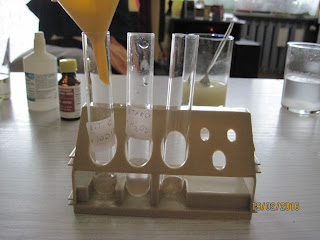This blog
has chemistry in its name, and I didn’t show any chemistry being done yet. Time
to rectify that! Today, I’m going to show you one experiment which you can try
for yourselves, because the components you need can be easily obtainable in
your nearest apothecary and grocery store. It’s really easy, really cool, and
completely safe.
What you
will need:
-
- Water (I’m using a filtered tap water, but unfiltered is fine, too)
- Starch (I used potato starch)
- Vitamin C
- Iodine
- Hydrogen peroxide 3%
- Glasses, spoons and if you have, gloves (iodine solution stains)
Just a bit of starch...
First, you
need to dissolve about 0,5 gram of starch in half of glass of hot water. It
doesn’t need to be precise amounts, you just need starch solution. Starch is dissolving with
some difficulty, so if your solution is cloudy, that’s perfectly fine. Let it
sit to cool.
And ascorbic acid...
Then,
dissolve about 0,5-1 gram of vit. C in half of glass of cold or warm water, but
not too hot or vitamin C will decompose. It’s best to crush it first to
dissolve it faster, but if you are using small tablets, like I did, you don’t
need to worry about crushing.
I'm using some test tubes I had lying around, but they are not vital to the experiment. They simply have a modifier +2 to Professionalism.
Okay, now
it’s time to combine our liquids. I decided to filter my vitamin C solution to
get a nice-looking, clear liquid. In one glass, combine about two tea spoons of
starch solution with about 5 teaspoons of hydrogen peroxide and dilute it with
water to about 1/3rd of a glass. Label it accordingly or, if you
want to be mysterious, Solution A.
Nitrile gloves add +5 to Professionalism. Also, protect from iodine stains.
In another glass, combine about one teaspoon
of vitamin C solution with one tablespoon of iodine and add water to about 1/3rd
of glass. You can label it Solution B.
Brown iodine turns colorless when mixed with vitamin C. This is meant to happen, because ascorbic acid reduces iodine to iodide ions.
Finally,
pour about equal amounts of both solutions into another glass, mix it, and wait
for the show.
Magic! I mean, chemistry!
The dark blue solution turns brown after a while, if too much iodine is released.
So, what is
happening here? Vitamin C (L-ascorbic acid) is reacting with elemental iodine,
causing it to turn into its ion form.
Then, as
the vitamin C gets used up, the elemental iodine is created in a reaction with
hydrogen peroxide.
H2O2
+ 2I− + 2H+ → I2 + 2H2O
We can
observe that thanks to the starch solution added to the mixture, which acts as
indicator for iodine. This type of reaction is known as a chemical clock or
clock reaction, because, depending on the reagents used, the reaction can
repeat itself several times. The reaction above can be reversed by adding more
vitamin C.
After the
experiment you can get rid of the waste simply by pouring it into sink with a
lot of water.
















